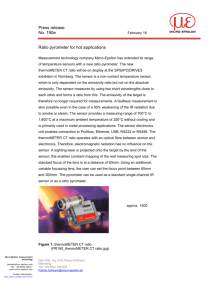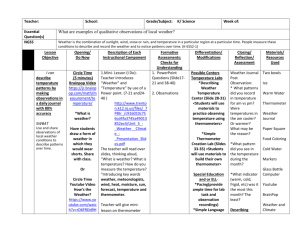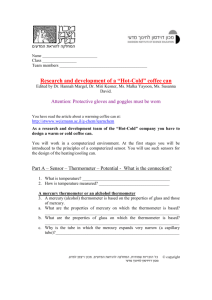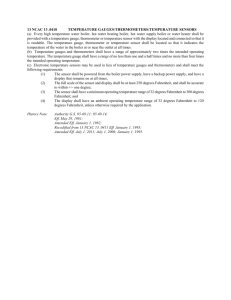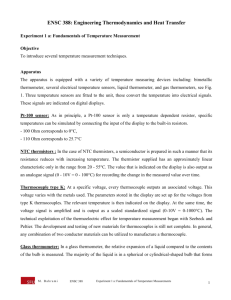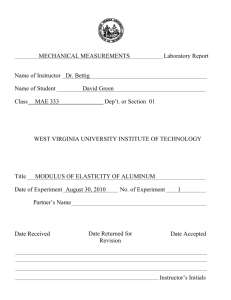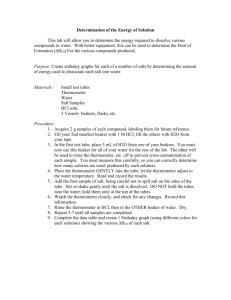INTRODUCTION TO METEOROLOGICAL INSTRUMENTATION
advertisement
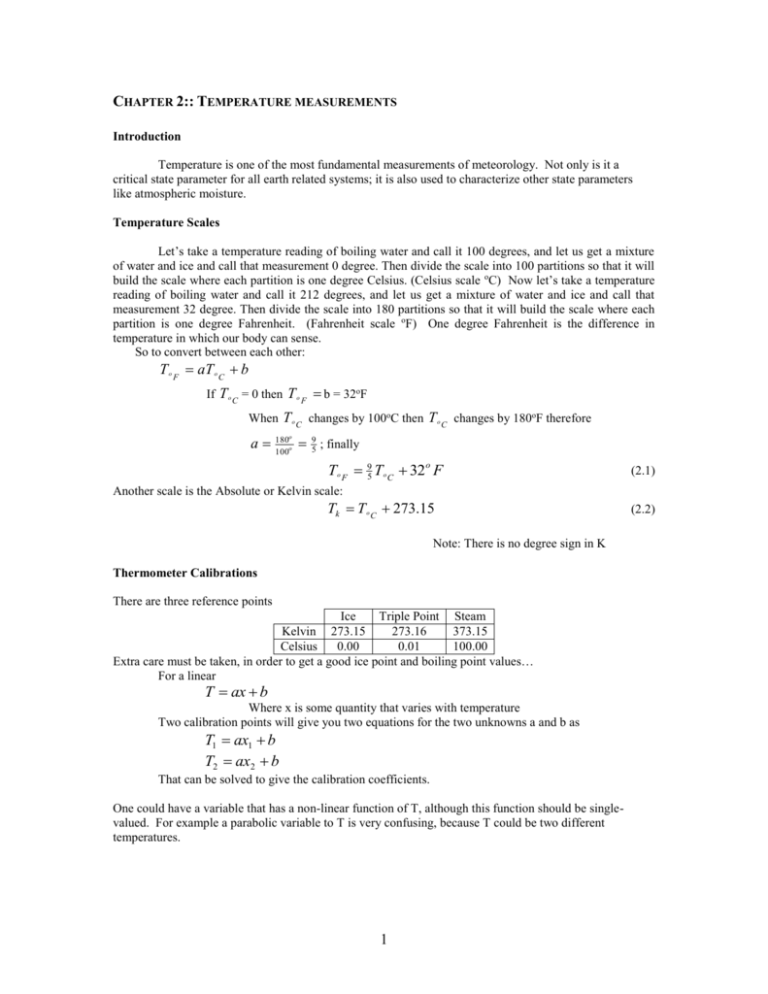
CHAPTER 2:: TEMPERATURE MEASUREMENTS Introduction Temperature is one of the most fundamental measurements of meteorology. Not only is it a critical state parameter for all earth related systems; it is also used to characterize other state parameters like atmospheric moisture. Temperature Scales Let’s take a temperature reading of boiling water and call it 100 degrees, and let us get a mixture of water and ice and call that measurement 0 degree. Then divide the scale into 100 partitions so that it will build the scale where each partition is one degree Celsius. (Celsius scale oC) Now let’s take a temperature reading of boiling water and call it 212 degrees, and let us get a mixture of water and ice and call that measurement 32 degree. Then divide the scale into 180 partitions so that it will build the scale where each partition is one degree Fahrenheit. (Fahrenheit scale oF) One degree Fahrenheit is the difference in temperature in which our body can sense. So to convert between each other: T o F aT o C b If T o C = 0 then T o F b = 32oF When T o C changes by 100oC then T o C changes by 180oF therefore a 180 95 ; finally 100o o To F 95 To C 32 o F (2.1) Another scale is the Absolute or Kelvin scale: Tk T o C 273.15 Note: There is no degree sign in K Thermometer Calibrations There are three reference points Ice Triple Point Steam Kelvin 273.15 273.16 373.15 Celsius 0.00 0.01 100.00 Extra care must be taken, in order to get a good ice point and boiling point values… For a linear T ax b Where x is some quantity that varies with temperature Two calibration points will give you two equations for the two unknowns a and b as T1 ax1 b T2 ax2 b That can be solved to give the calibration coefficients. One could have a variable that has a non-linear function of T, although this function should be singlevalued. For example a parabolic variable to T is very confusing, because T could be two different temperatures. 1 (2.2) Types of Thermometers Thermometers can be divided into two separate groups according to the level of knowledge about the physical basis of the underlying thermodynamic, namely, primary thermometers and secondary thermometers. For primary thermometers the measured property of matter is known so well that temperature can be calculated without any unknown quantities. Examples of these are thermometers based on the equation of state of a gas, on the velocity of sound in the atmosphere, and other mechanisms. Primary thermometers are relatively complex. Secondary thermometers are most widely used because of their convenience. Also, they are often much more sensitive than primary ones. For secondary thermometers knowledge of the measured property is not sufficient to allow direct calculation of temperature. They have to be calibrated against a primary thermometer at least at one temperature or at a number of fixed temperatures. Such fixed points, for example, triple points and boiling point. 1. Gas thermometer Gas thermometers measure the temperature by measuring the pressure changes of an ideal gas enclosed. According to the ideal gas law: PV mRT (1) where T is the absolute pressure of the gas; T is the temperature in Kelvin; V is the volume of the gas; m is mass of gas; and R is the gas constant. For constant volume gas thermometer, Eq.(1) can be written as V T const P mR This relation is known as Charles’s Law, which indicates that all we need is to measure pressure in order to calculate temperature. We can make a linear temperature scale in terms of pressure. This is because all gases have P = 0 at –273.15oC (i.e., T=0K). Note that all gases merge to the Absolute zero point, even though they have different slopes. 2. Liquid in glass thermometer Liquid in glass thermometers measure the temperature via volume expansion, V V The most common liquid in glass thermometer is the mercury-in-glass thermometer, invented by German physicist Daniel Gabriel Fahrenheit. Calibrated marks on the tube allow the temperature to be read by the length of the mercury within the tube, which varies according to the heat given to it. To increase the sensitivity, there is usually a bulb of mercury at the end of the thermometer which contains most of the mercury; expansion and contraction of this volume of mercury is then amplified in the much narrower bore of the tube. The space above the mercury may be filled with nitrogen or it may be a vacuum. Since the volume expansion of glass is about 1.2-2.7x10-5 per 1.00oC, which is small compared to that of Hg (18x10-5 per 1.00oC), this type of measurement is very accurate. The mercury-in-glass thermometer can be calibrated using triple point. Maximum thermometer Maximum thermometer works by having a constriction in the neck close to the bulb. As the temperature rises the mercury is pushed up through the constriction by the force of expansion. When the temperature falls the column of mercury breaks at the constriction and cannot return to the bulb thus remaining stationary in the tube. The observer can then read the maximum temperature over the set period of time. How does the constriction prevent the mercury from flowing back down the tube and into the bulb? It all has to do with pressure. The pressure at the constriction is much higher than the pressure in the rest of the tube. In order for the mercury to move into the bulb, it must overcome the pressure in the constriction. The free-flowing mercury does not have enough pressure to do this by itself and thus requires an outside force 2 (your hand shaking the thermometer) to overcome the constriction. This is similar to the design of a medical thermometer. Minimum thermometer A minimum thermometer measures the lowest temperature during a given period of time. It is a liquid-inglass thermometer that contains a barbell-shaped marker within the liquid. As the air temperature drops, the liquid and marker move down the thermometer tube. At minimum temperature, the liquid and the marker stop moving; as the temperature starts to rise, the liquid moves back up the tube, but the marker remains stationary. Thus the level of the marker represents the minimum temperature. The minimum thermometer must be held horizontally in order to work properly. To reset it, the thermometer is simply tipped upside down. Six's thermometer Six's thermometer is also known as a maximum-minimum thermometer, which can measure the maximum and minimum temperature during a given time. It was invented by James Six in 1782, and named after him. It consists of a U-shaped capillary tube with two separate temperature readings, one for the maximum temperature and one for the minimum temperature. There is a bulb at the top of the left arm (minimum reading scale ) of the U-shaped tube that contains alcohol. A chamber at the top of the right arm contains a vacuum or low pressure alcohol vapor. In the bend of the U tube is a section of mercury element, which is pushed around the tube by the expansion and contraction of the alcohol in the left arm bulb. At any given time the position of the mercury should be the same on both the maximum and minimum scales. If not then the instrument scales are not correctly positioned. In the left-hand bore, there is a minimum temperature index. A maximum temperature index is in the right-hand bore. As the mercury moves it pushes the two indexes. They record the furthest point reached by the mercury in each arm of the tube. When the temperature reverses and the mercury is moved in the opposite direction by the expansion or contraction of the alcohol, the sprung indexes remain in the tube at the furthest position they have been pushed by the mercury. They thus record the extremes of temperature experienced by the device since it was last reset. 3. Bi-metallic strip When accuracy is not critical, we can use bimetallic strip thermometer, which consists of 2 strips together with different thermal expansion sandwiched. In some applications the bi-metal strip is used in the flat form. In others, it is wrapped into a coil for compactness. The greater length of the coiled version gives improved sensitivity. 4. Electrical thermometers Electrical thermometers are useful for many applications. There are three types: thermocouples, resistance, and thermistors. Thermocouples: In 1821, the German–Estonian physicist Thomas Johann Seebeck discovered that when any conductor is subjected to a thermal gradient, it will generate a voltage. This is now known as the thermoelectric effect or Seebeck effect. So, using a dissimilar metal to complete the circuit creates a circuit in which the two legs generate different voltages, leaving a small difference in voltage available for measurement. That difference increases with temperature. A thermocople uses two junctions made with two dissimilar metals 3 the electromagnetic field (Emf) output from a thermocouple is proportional to the temperature difference between the distances. If absolute temperature is needed, one junction can be maintained at a reference temperature or known temperature. So say we want to find a formula per thermocouple response to different temperatures, to do that we would measure the melting point of ice. Then measure the temperature of one junction using another thermometer, then figure out the formula. The electronic reference junctions are available commercially for these thermocouples. Resistance thermometer: It exploits the predictable change in electrical resistance of some materials with changing temperature. The resistance thermal sensor can be made with small wires to give fast response. The resistance of a wire increases with temperature. Platinum which is commonly used for these thermometers have about 0.4 Ω oC-1 for a 100 Ω wire. The finer the wire the faster the response time is. There are two broad categories, "film" and "wire-wound" types. Film thermometers have a layer of platinum, which may be extremely thin, perhaps one micrometer. Advantages of this type are relatively low cost and fast response. Wire-wound thermometers can have greater accuracy, especially for wide temperature ranges. The coil diameter provides a compromise between mechanical stability and allowing expansion of the wire to minimize strain and consequential drift. Thermistors: They are semiconductors sensitive to temperature. They usually have a large negative resistance (1oC change gives about a 5% increase), and they can be made very small to give a very fast response. 5. Radiation thermometers: They are based on the principle that the radiation emitted from an object depends on its temperature. They are especially useful for remote sensing. The most common radiation thermometer is the infrared thermometer that measures temperature using blackbody radiation emitted from objects. They are, sometimes, called laser thermometers if a laser is used to help aim the thermometer, or non-contact thermometers to enhance the device’s ability to measure temperature from a distance. By knowing the amount of infrared energy emitted by the object and its emissivity, the object's temperature can be determined. The most basic design consists of a lens to focus the infrared energy on to a detector, which converts the energy to an electrical signal that can be displayed in units of temperature after being compensated for ambient temperature variation. This configuration facilitates temperature measurement from a distance without contact with the object to be measured. As such, the infrared thermometer is useful for measuring temperature under circumstances where thermocouples or other probe type sensors cannot be used or do not produce accurate data for a variety of reasons. 4 Thermometer Response Time The repose time of a thermometer is a very important parameter that determines the main characteristics of the sensor and can vary substantially. One may use a step function to estimate the sensor’s response time. If the initial equilibrium temperature of a thermometer is T o and the final temperature is Ta, the response time, or we say time constant, is the time that sensor needs to change from To toTa. Apparently, the smaller the time constant τ, the faster the thermometer’s response time to a given temperature change. Factors that control the time constant: The characteristics of the sensor and of the medium being sampled affect the time constant τ. The factors important in determining this coefficient are the heat capacity of the sensor and the heat transfer rate. The constant will be proportional to the heat capacity and inversely proportional to heat transfer rate. The heat capacity of the sensor may be represented as (2.1) Cs cs m where m is the mass and cs is the specific heat capacity. Since the mass can be represented as where m V is the density and V is the volume of the sensor, so that C s cs V (2.2) In air, the rate of energy loss from the sensor due to convective processes will be proportional to the area of the sensor A and the convective heat flux Hconv that depends on the ventilation of the sensor and sensor geometry. For temperature measurements in a liquid or solid, the relevant energy transfer will be associated with conductive properties of the medium. The total heat transfer from the sensor can then be written as AHconv. With these expression for the heat capacity and transfer rates csV AH conv c s d H conv (2.3) where d is a size parameter whose relationship between V and A depends on the geometry of he sensor. This expression shows that the smaller the sensor the higher the convective heat transfer rate, then the smaller the time constant. For some application, the sensor may be too fragile, if the size is too small. The heat transport is proportional to the ventilation rate of the sensor. Empirical studies indicate that τ can be related to the ventilation rate U as aU b (2.4) where b is ~ -0.5. Thus, as ventilation increase, τ decreases. Making temperature measurements in the air Firstly air is a poor conductor, thus, a good flow over the sensor should be maintained. Secondly conduction errors require that sensor to be thermally insulated from the mounting. Thirdly radiation error results if the sensor is exposed to solar radiation. The sensor also emits and absorbs longwave radiation. Some of these problems can be eliminated using a polished or a coated sensor that reflects solar radiation and that has a low infrared emissivity. A shield can be used to shelter the sensor, but under some contains this shield needs to be aspirated to ensure proper ventilation. Also the heating of the sensor by adiabatic compression occurs when a temperature sensor is exposed to air moving at very high rates. This problem is most pronounced when making air temperature measurements from air craft. Adiabatic heating is easily corrected using the air speed of the aircraft. Lastly wetting of a temperature sensor will lower the measured temperature due to evaporative cooling. Upper air measurements can be affected as a sensor goes though a cloud. For surface measurements, the radiation shield also keep the sensor dry. 5 Sensor exposure Exposure standards are necessary to define what is meant by adequate exposure for certain applications. For example, what is meant by surface temperature on synoptic scales? Is it acceptable to mount the temperature sensor beside a building? How about on the roof of a building? For synoptic observations, we want the measurement to be representative of a large area. At what height above the ground should measurements be made? World Meteorological Organization/Commission for Instruments and Methods of Observations (WMO/CIMO) has clear recommendations about siting and exposure of instruments. The temperature sensor, according to WMO, should b exposed in a radiation screen, with or without forced ventilation, at a eight of 1.25 m to 2.00 m above the ground surface. The screen must be not be shielded by or close to trees, buildings or other obstructions. The measurement site must not be on a steep slope or in a depression where thermal conditions might not be representative of the larger scale. Exposure on top of buildings is not recommended because of the vertical temperature structure in the atmosphere and the perturbation caused by buildings. Where snow is persistent, it is acceptable to maintain the sensor at a constant height above the snow surface. 6


